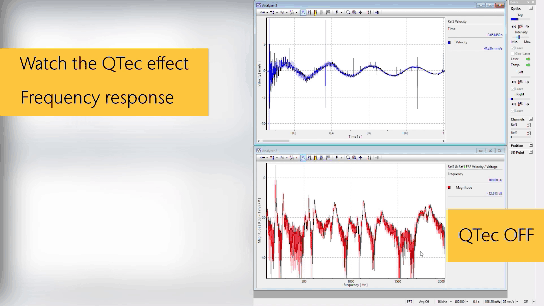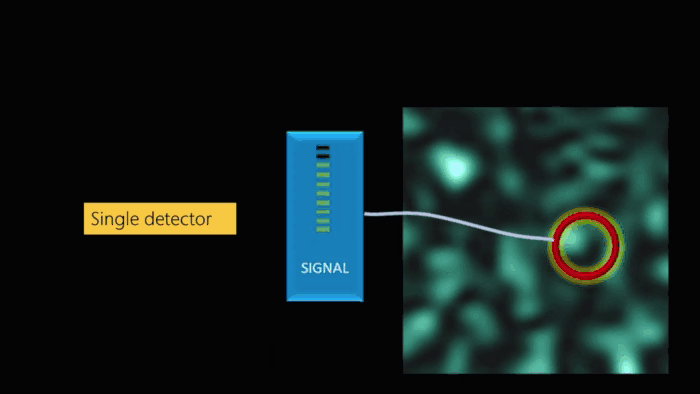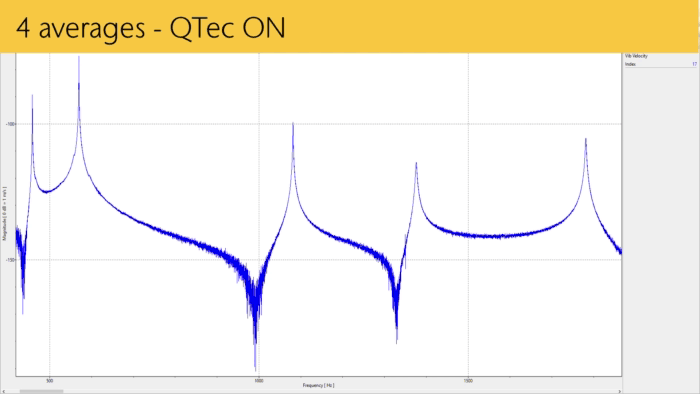Multipath Doppler vibrometry for validating complex models accurately and without contact
Multipath Doppler vibrometry, carrying the trademark QTec® at Polytec, has raised conventional non-contact vibration sensing to the next level. Thanks to its novel optical design, vibrometer data can now be obtained faster and more reliably even if no surface treatment is applied to the test object. QTec® is designed for real world applications in potentially adverse environments, where the optical properties of the test surface are not well controlled. Reliable performance of QTec® gives the test engineer confidence in the data while making the acquisition process efficient and hassle-free on the most challenging test articles.
The QTec® Effect
The effect of QTec® can be seen very nicely in the animation below. The time trace (upper image) exhibits spikes when QTec® is not turned on. Such spikes are called optical dropouts and can occur spontaneously with conventional vibrometers, especially in the presence of lateral motion. Dropouts in the time domain signal translate into a sudden increase of broadband noise in the frequency spectrum as illustrated in the lower image.

Best signal-to-noise ratio (SNR) with QTec. Image Credit: Polytec
The Solution: Change the Perspective
QTec® is designed to remove dropouts from the signal and thus ensures high-quality vibration data consistently even if the test surface is optically un-cooperative. The signal-to-noise ratio (SNR) still depends on the amount of return light, however, this relationship is very well controlled. The choice of an infrared (IR) laser source at 1550nm allows for a very high photon count while being eye safe (compliant with laser class 2). Photon count is a critical parameter in photonics as the shot noise on the photodetector is the main source of noise in an optical sensor. Incidentally, the sensitivity of a QTec® vibrometer on a dark surface is often still in the nanometer or even picometer range.
Dropouts are caused by the inherent speckle nature of laser light when viewing the image plane of a reflection on a rough surface. The animation below illustrates such a speckle pattern and its movement during a test. The size of the photodetector is indicated by the red circle. Speckle movement can cause the photodetector to fall in between bright speckles leading to a temporary loss of signal, which causes a dropout in the vibration data. QTec® incorporates multipath interferometry, using multiple photodetectors, and ensures sufficient return light at least on one of the detectors. Such an optical arrangement drastically reduces the likelihood of dropouts. Ultra-fast electronics and smart algorithms inside the QTec® pick the best performing detector in real time producing a vibration signal that is continuously clean and without dropouts.

With multiple detectors, QTec achieves a high and stable signal level and best noise performance. Image Credit: Polytec
QTec® Simplified Principle of Multipath Laser Vibrometry
QTec® multipath interferometry for fast and efficient vibration measurement
Multiple detection channels of QTec combine the full picture of vibration dynamics. Video Credit: Polytec
In another example shown below, the quality of the frequency response function (FRF) is cleaner with QTec and only 4 averages when compared to the FRF taken without QTec and 16 averages. Resolving the anti-nodes in the FRF is crucial for accurate modal model validation of complex structures as the peaks as well as the valleys have to be curve fitted exactly.

In a practical example, QTec provides the same performance 4x faster. Image Credit: Polytec
As Qtec’s novel optical interferometer arrangement delivers consistent quality of the measurement data, the need for post-processing and averaging is greatly reduced. Measurements can be taken in a fraction of time when compared to conventional vibrometry. The setup is simpler, not having to apply surface treatment, and the actual measurement times are reduced due to the lower number of averages needed.
Performance and usability is key for the test engineer to efficient in today’s demanding product development cycles. QTec has created quantum leap in non-contact vibration testing many industries will benefit from.